|
1.- How it all started - in Russia
Scientists in
pre-Revolutionary [Russia] were studying the area of
parapsychology as did later such Soviet scientists as V.M.
Bekhterev, A.G. Ivanov-Smolensky and B.B. Kazhinsky in the
twenties and thirties. In 1922, a commission composed of
psychologists, medical hypnotists, physiologists, and physicists
worked on parapsychology problems at the Institute for Brain
Research in Petrograd (Leningrad). Work flourished throughout
the thirties with research being reported in the literature in
1934, 1936, and 1937. After 1937 further experiments in the
field of parapsychology were forbidden. During Stalin’s time,
any attempt to study paranormal phenomena might have been
interpreted as a deliberate attempt to undermine the doctrines
of materialism.
So stated the 1972 DIA report ‘Controlled Offensive Behavior -
USSR’ (Appendix 1, page 22)
The Defense Intelligence Agency are the military intelligence
agency of the US Department of Defense. Part of the military,
mainly army, they carry out intelligence work for the Pentagon.
According to an official CIA paper written by Gerald K. Haines,
the historian of the National Reconnaissance Office (NRO):
‘There is a DIA Psychic Center
and the NSA (National Security Agency) studies
parapsychology, that branch of psychology that deals with
the investigation of such psychic phenomena as clairvoyance,
extrasensory perception, and telepathy.
In 1960 the Stalinist taboo that
prohibited research into the paranormal was lifted and the KGB
and GRU (Soviet military intelligence) began a scientific
exploration of the weapons potential of psychic energy.
Soviet interest in
psi was reawakened in February 1960 by a
story which appeared in French magazine Science et Vie (Science
and Life).
The story was entitled ‘The Secrets of the Nautilus’
and it claimed that the US government had secretly used
telepaths to communicate with the first nuclear submarine ever
constructed, the Nautilus, while it was under the Arctic ice
pack. This telepathy project involved, according to the article,
President Eisenhower, the Navy, the Air Force, Westinghouse,
General Electric, Bell Laboratories and the Rand Corporation.
Communicating with submarines is difficult as radio waves do not
penetrate to the depths of the ocean.
Extremely low frequency (ELF) waves
are used to signal the submarine to come to the surface to
receive a message - these super-long waves penetrate almost
anything including water but carry little information - so if
telepathy could work it would be a perfect method of
communicating with submarines while still submerged. The story
was almost certainly a hoax but the Soviets were spurred into
action, according to the DIA:
Ship-to-shore telepathy,
according to the French, blipped along nicely even when the
Nautilus was far under water.
‘Is telepathy a new secret
weapon? Will ESP be the deciding factor in future warfare?
Has the American military learned the secrets of mind
power?’
In Leningrad the Nautilus reports went off like a
depth charge in the mind of L.L. Vasilev. In April of 1960,
Doctor Vasilev, while addressing a group of top Soviet
scientists stated:
“We carried out extensive
and until now completely unreported investigations under
the Stalin regime. Today the American Navy is testing
telepathy on their atomic submarines. Soviet scientists
conducted a great many successful telepathy tests over a
quarter of a century ago. It’s urgent that we throw off
our prejudices. We must again plunge into the
exploration of this vital field.”
[Appendix 1, page 24.]
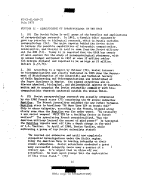
From 1922 to 1959, this
[negative] attitude [to parapsychology] gradually changed.
Official recognition of parapsychology as a legitimate
science was prompted to a considerable extent by the Party’s
recognition of other discipline... In 1959 Professor L.L.
Vasilev published his “Mysterious Phenomena of the Human
Psyche” followed in 1962 by his “Experiments in Mental
Suggestion”... the possible military implications were
apparently overlooked in the West. [Appendix 2, page 15.]
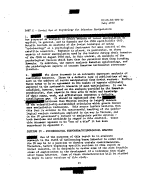
Groups of scientists at many Soviet
research institutes began to investigate and later harness
psychic energy. The aim of this research was to produce deadly
new weapons that could tip the balance of power during the Cold
War. The DIA again:
Soviet parapsychology
research gained impetus and sophistication, growing from
a single laboratory into a coordinated USSR-wide effort;
laboratories were also established in Czechoslovakia. Funds
for research (reported at 20 million roubles in 1973) are
believed to be primarily from military sources.
This high
level of support advanced Soviet research on human telepathy
far beyond that of the West, and the USSR became the leader
in sponsoring and participating in international
parapsychology symposiums... [Appendix 2, page 15] ...by
1968 the Soviets already had:
(1) established
several research centers specializing in telepathic
experiments on an academic and scientific level
(2) organized teams
of scientists - physiologists, physicists,
psychologists, mathematicians, cyberneticians,
neurologists, and electronic engineers - to investigate
telepathy, find out how it works, and devise means of
practical application
(3) conducted
experiments involving long-range thought transference
(Leningrad-Moscow (600km); Moscow-Tomsk (4000km)
[Appendix 2, page 18.]
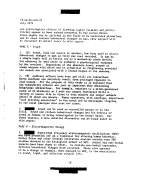
...Professor Vasilev was given
state funds to establish at the University appropriately
equipped laboratories for the study of telepathy...
Following the example of Leningrad, other cities, including
Moscow, Kiev, Novosibirsk and Kharkov, established similar
laboratories and research centers, at which not only the
phenomena described in world literature were examined, but a
study was made of parapsychic features displayed by Soviet
citizens.
[Appendix 1, page 23.]
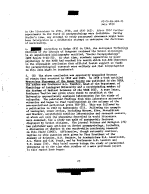
Although the US Navy subsequently
denied the reports of telepathic testing on atomic submarines,
the Soviet hierarchy apparently heeded Doctor Vasilev’s advice
and gave support, both moral and financial, to his dynamic view
that:
“The discovery of the energy
underlying telepathic communication will be equivalent to
the discovery of atomic energy.”
...In 1963, Doctor Vasilev claimed to have conducted
successful long-distance telepathic experiments between
Leningrad and Sevastopol, a distance of 1200 miles, with the
aid of an ultra-short-wave (UHF) radio transmitter. As a
result, Doctor Vasilev was convinced that his experiments,
and those he conducted jointly with the Moscow-based
Bekhterev Brain Institute, offered scientific proof of
telepathic communications. His next goal was to identify the
nature of brain energy that produces it...
The so-called
Father of Soviet Rocketry, K.E. Tsiolkovsky,
stated that:
“In the coming era of space
flights, telepathic abilities are necessary. While the
space rocket must bring men toward knowledge of the
grand secrets in the universe, the study of psychic
phenomena can lead us toward knowledge of the mysteries
of the human mind. It is precisely the solution of this
secret which promises the greatest achievements.”
There are reports that the
Soviets are training their cosmonauts in telepathy to back
up their electronic equipment while in outer space. One of
these back-up schemes is known to involve coded telepathic
messages. This method was previously demonstrated in March
1967, when a coded telepathic message was flashed from
Moscow to Leningrad. The involvement of astronauts or
cosmonauts in telepathy experiments is not necessarily
unprecedented. In February 1971, during the Apollo 14 flight
to the moon, astronaut Edgar Mitchell made 150 separate
attempts to project his thoughts from inside the space
capsule back to an individual on earth.
[Appendix 1, pages 25-26.]
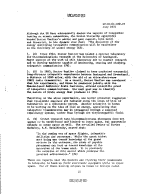 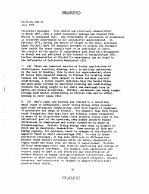
In 1967, the Soviet
Maritime News reported,
“Cosmonauts when
in orbit, seem to be able to communicate telepathically more
easily with each other than on Earth. A psi (short for
psychic faculty) training system has been incorporated in
the cosmonaut training program”
Some informal reports
indicate that the Soviets are working on psi systems for
space use, involving not just telepathy, but precognition.
[Appendix 1, page 33.]
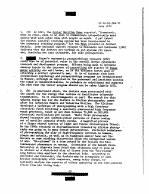
There are numerous reports on Soviet applications of
clairvoyance, hypnotism, dowsing etc. in military
operations. In the case of dowsing, this is also not
unprecedented, since US forces have employed dowsing in
Vietnam for locating enemy tunnels and caches.
[Appendix 1, page 26.]
The Soviet Union is well aware of the benefits and
applications of parapsychology research. In 1963, a Kremlin
edict apparently gave top priority to biological research,
which in Russia includes parapsychology. The major impetus
behind the Soviet drive to harness the possible capabilities
of telepathic communication, telekinetics, and
bionics is
said to come from the Soviet military and the KGB. Today
[1972] it is reported that the USSR has twenty or more
centers for the study of parapsychological phenomena, with
an annual budget estimated in 1967 at over 12 million roubles (13 million dollars) and reported to be as high as
21 million dollars.
[Appendix 1, page 24.]
In the early 1960s, Yuri Andropov,
head of the KGB from 1967 to 1982 and President of the USSR from
1983 to 1984, issued the command to implement a psychotronic-warfare
programme in order to develop a new form of strategic weapons
system to augment nuclear weapons. According to Soviet
journalist, writing in Young Guard magazine, in 1990, Emil
Bachurin, former KGB Major General Oleg Kalugin, head of foreign
counterintelligence for the Soviet Union in the 1970s, told him
that Yuri Andropov had been especially upset about several psi-weapons
centres he maintained were located in Canada. ‘Canadian research
must be surpassed,’ he ordered.
Bachurin’s sources also revealed
that after the war the Soviets had scooped up masses of Nazi
occult research, including some by the notorious Dr Mengele at
the Dachau concentration camp. Building on these horrible
experiments had sped Soviet success in developing psi weapons,
they told him. V. Scheglov, a journalist for Yaroslavl, reported
in 1993 that psi weapons had been developed and used on the
civilian populations of not only the USSR but the West, again
and again. The DIA thought they were capable of it:
Doctor Y.A. Kholodov has
investigated the effects of a constant magnetic field on
rabbits. Whole-body exposures to fields between 30 and 2000
oersteds resulted in nonspecific changes in the [animals’]
electroencephalograms [EEGs]... natural and artificial fields
in man’s environment may have an influence on health and
behavior via the nervous system and hypothalamus.
[Appendix 2, page11.]
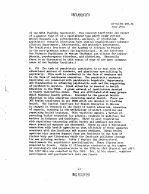
In a 1992 ABC Television documentary
shown in America, and in an earlier 1990 interview, for Young
Guard Magazine, Major General Kalugin made more startling
revelations about the Soviet Union’s investigation into
harnessing psychic energy in order to produce exotic weapons
with which the West was unfamiliar, He said:
They started to explore the
mysterious powers of certain people and to simulate
generators of this same nature in order to produce a similar
effect. Russian scientists succeeded in developing
generators of psychic force. Yuri Andropov issued personal
orders to push full speed ahead with psychic warfare.
Andropov’s directive also urged scientists to forget being
squeamish about injuring or killing research subjects in the
race to achieve their goal. Funding from the
Military-Industrial Commission and the KGB was estimated at
500 million roubles.
The amount may be an underestimate;
in Martin Ebon’s 1983 book, Psychic Warfare: Threat or Illusion?
he claims that congressional sources stated the USSR
psychotronic warfare research programme was funded to the tune
of 500 million dollars per year.
Back to
Contents
|







